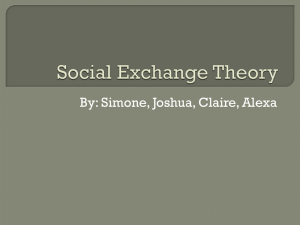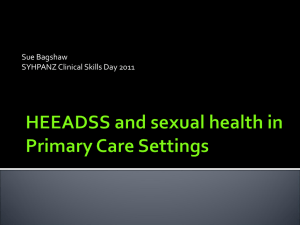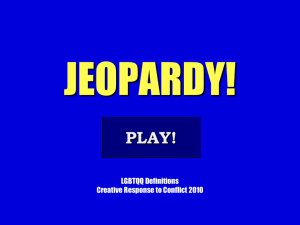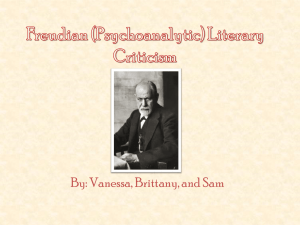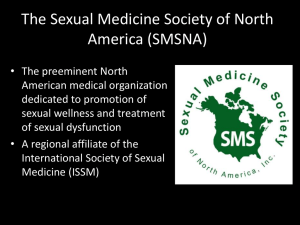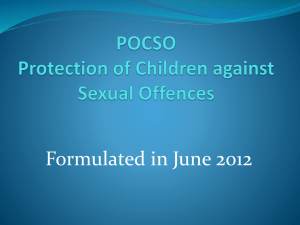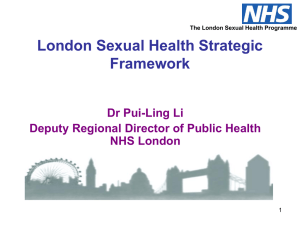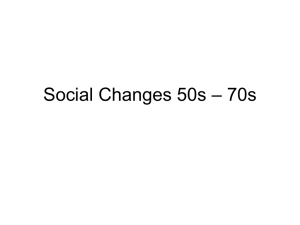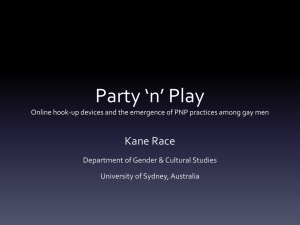Sexual Offending
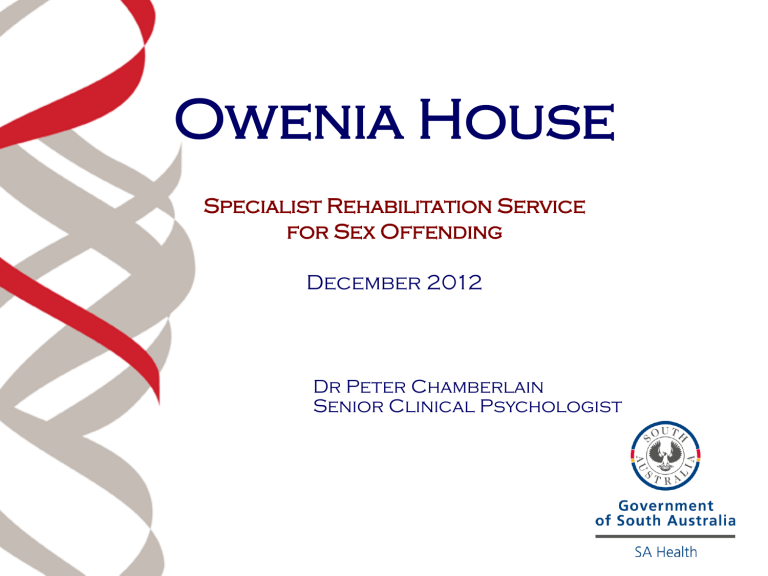
Owenia House
Specialist Rehabilitation Service for Sex Offending
December 2012
Dr Peter Chamberlain
Senior Clinical Psychologist
Owenia House: Effectively a behavioural clinic within the Forensic Mental health Service
Our core objective is to prevent sexual abuse of children by intervening with offenders and potential offenders
Provides:
Community based assessment and treatment services for adults who have sexually offended against children, or fear they may do so .
A treatment service for paraphilias e.g. exhibitionists, public masturbators
Owenia House
(As at 12 December 2012)
Staff:
6
Director, 4 Clinicians, Administrative Officer
Clients
: 72*
(waiting list of 23)
All Male, average age 43 with ages ranging from 19 - 74
* We have a capacity for approximately 120
Groups:
(Closed/Open)
Standard (2 phased) – normally functioning
Skills Based Treatment – intellectually impaired
Rural – rural clients, normal functioning, full day each month
Individual Sessions:
NOS (other paraphilias & child sex offenders as required)
Offending
Trajectory
Therapeutic
Philosophy
Principle Theoretical Models
> Finklelhor’s (1984) Precondition Theory motivation*, internal and external barriers and victim resistance
*3 components:
emotional congruence: emotional need to relate to children
sexual arousal: children are a potential source of sexual gratification
blockage: adult sexual & emotional gratification unavailable
> Ward & Stewart’s (2003) ‘Good Lives’ Model
constructive & holistic approach beyond a single focus on risk management
enhancement drives rehabilitation
realising an offending-free life that is beneficial and rewarding in ways that are socially acceptable & personally fulfilling
Principle Theoretical Models Continued:
Theoretical morphing:
Finklelhor's
Precondition Theory
Hall & Hirschman’s
Quadripartite Theory
(critical threshold)
Marshall & Barbaree’s
Integrated Theory
(negative early – life experiences
Pathways Model of Child Sexual Abuse
(Ward and Siegert 2002)
Intimacy Deficits
Normal sexual scripts
Offend at specific times; child is pseudo-adult
Deviant Sexual Scripts
Distorted (subtle) sexual scripts
Interact with dysfunctional relationship schemas
Multiple Dysfunctional
Mechanisms
Deviant sexual scripts
Deviant fantasies
Generally comorbid psychopathologies
Sexual
Offending
Emotional Dysregulation
Normal sexual scripts
Dysfunctional emotional regulation
Antisocial Cognitions
No distorted scripts
Offending reflects general pro-criminal beliefs/attitudes
Typologies of Child Sex Offenders
Preferential (fixated) versus Situational (regressed) offenders.
Fixated : Primary sexual orientation is to children
interest generally begins in adolescence,
- pre-planned, premeditated persistence interest
- males primary target
Regressed : Primary sexual orientation to age mates
interest in children emerges in adulthood
- pseudo adult substitute
- females primary target
General Characteristics
Clinical Profile Considerations (DSM-IV-TR) :
Axis 1 (Clinical Disorders)
depression common (suicidal),
psychosis 5-8%,
Axis 2: (Personality & Intellectual Disorders)
Personality disorder 5-7%
Intellectual disability 15%
Presentation variable
Sexual abuse (estimates 40-50%); earlier and more severe abuse associated with earlier offending
Criminality
> 60 % of child sexual offenders have at least one previous conviction
almost twice as likely to have been for non-sexual offences than for sexual offences.
Sexual Preference
48% of non-familial offenders have arousal to children.
28% of father-daughter incest offenders have arousal to children.
15% of non-offender males have arousal to children.
Assessment
Referral Information
Current Legal status
Detailed personal history
(family of origin & current family situation, relationship history, education, occupation, medical & mental health history, medications, substance use/abuse)
Sexual and non sexual offending history
Detailed sexual history
Psychometrics as indicated
Recidivism risk
Sexual attitudes and beliefs inventories
Treatment Plan
Degrees of Denial
WHY DID YOU SEXUALLY ASSAULT THE VICTIM?
NOTHING HAPPENED
‘I never laid a finger on her’
‘The boy’s lying’
‘The cops are out to get me’
AND
IT WAS WRONG
BUT
THERE WERE EXTENUATING
SITUATIONAL CIRCUMSTANCES
‘I was having money problems’
‘I was drinking too much’
‘My wife wouldn’t sleep with me’
SOMETHING HAPPENED
BUT AND
IT WASN’T MY IDEA
‘The kid came on to me’
‘She was all over me’
IT WAS MY IDEA
BUT
AND
IT WASN’T SEXUAL
IT WAS SEXUAL
BUT
IT WASN’T WRONG
‘There’s nothing wrong with it’
‘She liked it’
‘I was being affectionate’
‘I was angry at my wife’
‘I was teaching her to be careful’
BUT
THERE WERE EXTENUATING
PSYCHOLOGICAL FACTORS
‘I was sexually abused as a child’
‘I don’t know what got into me’
‘Women scare me’
Group Treatment Programmes
Closed (set programme, 2 stage)
Open/Continuous (own pace, enter & at leave different times)
Intensive (Country, short time)
Skills-based (IQ compromised)
SOIG (Information, support, supervising adult)
* NOS (Other paraphilias) – Individual Treatment
Group Content
cognitive, behavioural, situational antecedents, values
pattern/offence cycle
high risk moods and thinking
concept irrelevant decisions
lapses and strategies
developing support network
changes in lives – focus/orientation to children
individual relapse prevention plan
Offending Cycle
Offending Behaviour
Along continuum of sexual aggression
4
Self - Centred Internal Conflict
Shame, self-pity, personality driven depression, self-defeating behaviour
5
6
Self - Directed Cognitive
Distortion
Denying, rationalising, minimising, sanitising, and avoiding detection
Offence - Directed Behaviour
Victim targeting, grooming, setting up the offence scenario
3
Conscious Intentions to
Offend
Acting in a manner that enhances the fantasies, imagery, arousal and/or impulses
2
1 Deviant Sexual Fantasies and Images
Experiencing feelings/arousal that reinforces the deviant imagery
Treatment Goals
Understanding patterns of abusive behaviour
Understanding consequences of abusive behaviour
Victim empathy
Take responsibility for actions
Changing associated emotional, behavioural and lifestyle patterns
Recognition of lapses
Individualised risk management programme
End of Treatment Expectations
responsibility for abusive behaviour
responsibility for future offence-free life
disclosure of personal information
recognition pro-offending attitudes
avoidance of minimising/justifying effects
insight into victim issues
understanding impact lifestyle factors
understanding and implementing relapse prevention strategies
motivation to change as evidenced by value action plan
Treatment Success
Heterosexual: treated untreated
Homosexual: treated untreated
Familial/Incest treated untreated
18%
43%
13%
43%
(7.5%)
(18%)
(5.5%)
(19%)
8% (3%)
22% (7%)
NB Figures outside of brackets are unofficial police records and child protection services statistics. Those inside brackets are official police records.
Referral Criteria
Two pathways: Mandated or Voluntary
Criteria:
1.
Must have sufficient time if mandated
2.
Voluntary must self-refer and not be before the court
3.
Offences must have been against children (i.e. adult victim offences not accepted). NOS clients the exception
4.
Must accept some responsibility (deniers precluded)
5.
>17 years of age
6.
Male
Referral/Discharge considerations
> No child contact
> Likelihood for change
> Motivation for change
> Social supports
